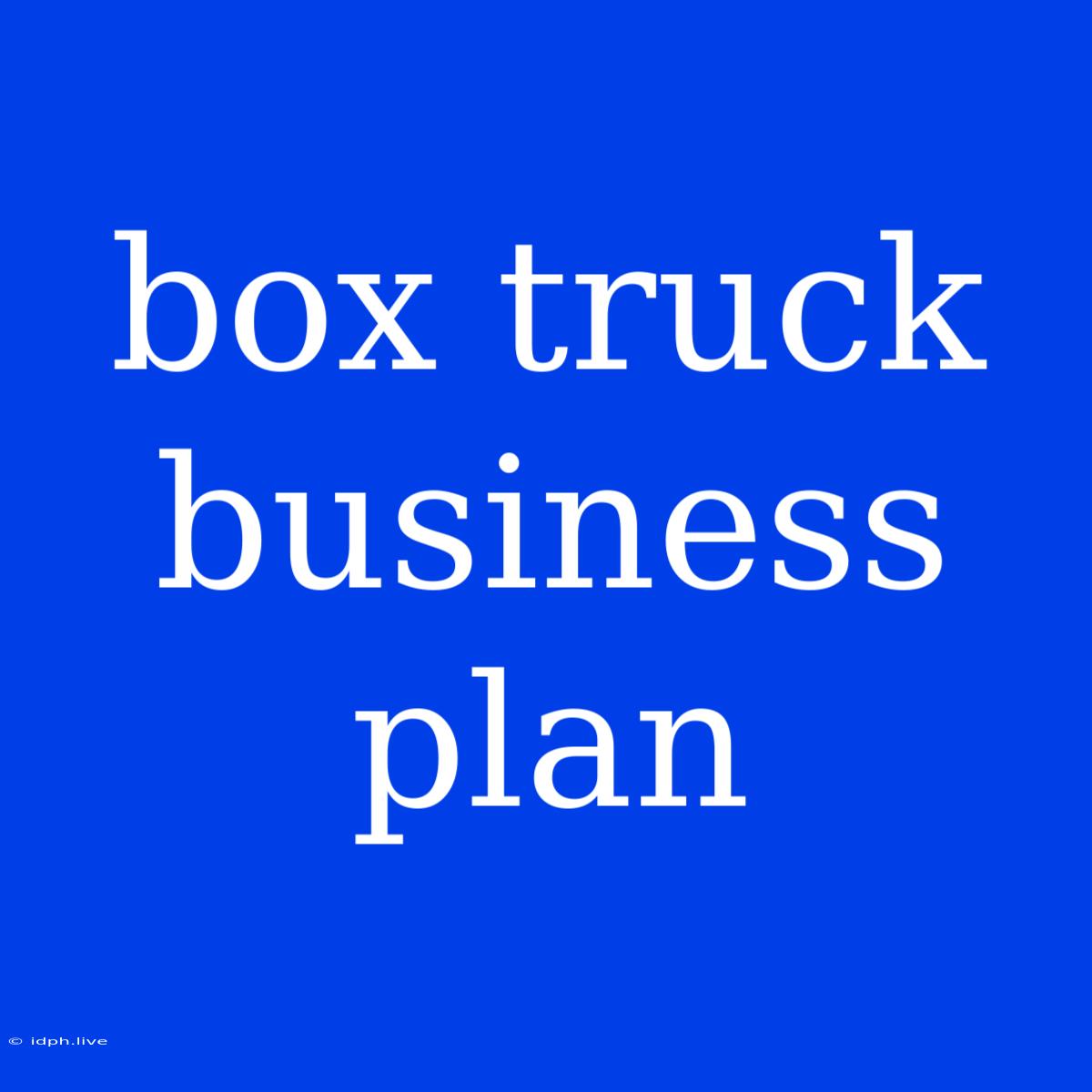Box Truck Business Plan: A Comprehensive Guide to Success
Starting a box truck business can be a lucrative venture, especially with the growing demand for efficient delivery and transportation services. This comprehensive guide will help you develop a well-structured business plan, increasing your chances of success.
I. Executive Summary
This section provides a concise overview of your box truck business. It should highlight your target market, services offered, business model, and anticipated financial projections.
II. Company Description
- Business Name: Choose a memorable and relevant name that reflects your services.
- Mission Statement: Briefly explain your core purpose and values.
- Services: Detail the specific transportation services you will offer. This could include:
- Local delivery: Delivering goods within a specific geographical area.
- Long-haul transportation: Transporting goods over longer distances.
- Specialized services: Offering niche services like refrigerated transportation or hazardous materials handling.
- Target Market: Define your ideal customers. This could be businesses, individuals, or specific industries.
- Competitive Advantage: What makes your business stand out from competitors? This could be competitive pricing, specialized services, or exceptional customer service.
III. Market Analysis
A. Industry Overview: Research the current state of the box truck industry. Identify growth trends, challenges, and opportunities. B. Target Market Analysis:
- Demographics: Understand the characteristics of your target market, including age, income, and location.
- Needs & Preferences: Identify the specific transportation needs and preferences of your target market.
- Competition: Analyze your key competitors, their strengths and weaknesses, and their pricing strategies.
IV. Marketing Plan
A. Marketing Strategies:
- Branding: Develop a strong brand identity to differentiate your business.
- Website and Online Presence: Create a professional website with information about your services, pricing, and contact information.
- Social Media Marketing: Leverage platforms like Facebook, Instagram, and LinkedIn to reach potential customers.
- Networking: Build relationships with industry professionals and potential clients through trade shows and events.
- Word-of-Mouth Marketing: Encourage satisfied customers to refer your services. B. Pricing Strategies:
- Cost-Plus Pricing: Calculate your costs and add a markup to determine your price.
- Competitive Pricing: Match or undercut your competitor's prices.
- Value-Based Pricing: Charge premium prices for specialized services or exceptional customer service.
V. Operations Plan
A. Vehicles:
- Number of Trucks: Determine the initial number of box trucks needed based on demand and service offerings.
- Maintenance & Repair: Establish a comprehensive maintenance plan to ensure the reliability and safety of your trucks.
- Insurance: Obtain adequate insurance coverage for your vehicles and operations. B. Personnel:
- Hiring: Develop a hiring plan for drivers and other staff.
- Training: Provide proper training for your employees, including safety protocols and customer service.
- Compensation and Benefits: Establish competitive salaries and benefits packages to attract and retain qualified employees. C. Dispatch and Logistics:
- Route Optimization: Implement efficient route planning software to minimize delivery times and costs.
- Inventory Management: If offering storage services, develop a system for managing inventory and ensuring timely delivery.
VI. Financial Plan
A. Start-Up Costs:
- Truck Purchase or Lease: Estimate the cost of acquiring or leasing trucks.
- Insurance: Calculate insurance premiums for your vehicles and operations.
- Maintenance and Repairs: Estimate ongoing maintenance and repair expenses.
- Marketing and Advertising: Budget for marketing and advertising campaigns.
- Working Capital: Secure funds to cover operational expenses during the initial period. B. Revenue Projections:
- Forecasting: Estimate your expected revenue based on your target market and pricing strategy.
- Sales Growth: Project your anticipated revenue growth over time. C. Profitability:
- Profit Margin: Calculate your desired profit margin.
- Break-Even Analysis: Determine the sales volume needed to cover your operating expenses. D. Funding Sources:
- Personal Savings: Invest personal funds to start your business.
- Loans: Explore loans from banks or credit unions.
- Investors: Seek funding from private investors or venture capitalists.
VII. Management Team
- Management Structure: Outline the organizational structure of your business.
- Key Personnel: Identify the key individuals responsible for different areas of operations.
- Experience and Expertise: Highlight the experience and expertise of your management team.
VIII. Appendix
Include any supporting documents, such as:
- Financial statements
- Market research reports
- Insurance policies
- Contracts with vendors
Remember, this is a basic framework for a box truck business plan. You will need to tailor it to your specific needs and circumstances.
By carefully planning and executing your strategy, you can increase your chances of success in the competitive box truck industry.

